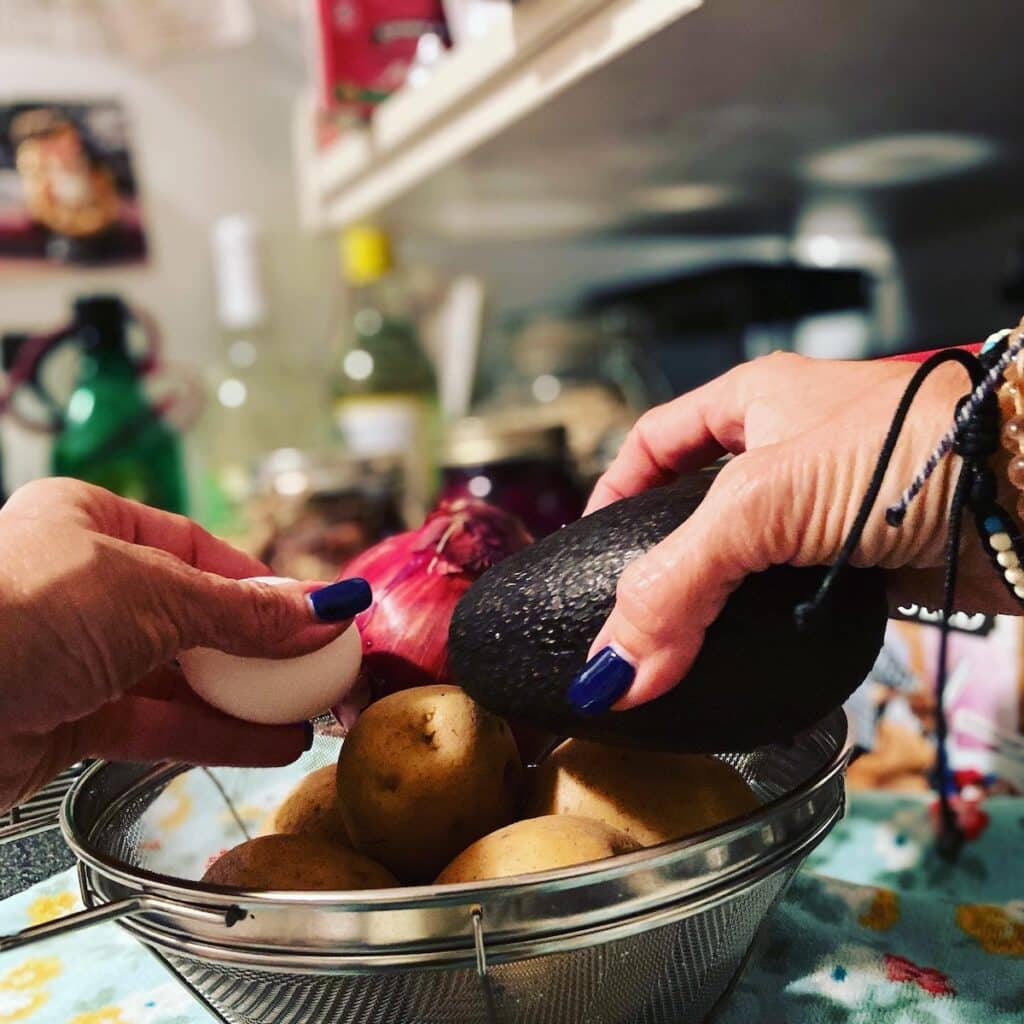I went from consistently weighing 138 to consistently weighing 121. Now let’s get this out in the open. We are not the same and if you are trying to get your weight to a number based on someone else’s body then you are setting yourself up to fail. I am 5’3 and definitely a small boned person. I always wished I was 6 foot and 185 pounds but I am not and there is zero chance of that happening.
Ask yourself first, “how do I feel?” If you feel swollen and puffy, stiff and fatigued then maybe reassess your nutrition before you join the gym or go buy new running shoes. If you feel active and agile and strong then you may not need to look at the scale. My journey was about helping my body carry me through to the next 50 years. The weight I carry is in my mid section which is indicative of celiac disease and menopause. My weight lowered when I changed my eating style and habit not because I dieted or increased my physical activity.
I am 100% supportive of joining a gym and buying new running shoes. I have been a competitive athlete my entire life and I am days shy of 56. But after being diagnosed with Celiac disease, I made changes that I probably would not have had I not been born with Celiac. But good things come from all kinds of obstacles. Now I am better for having rid my daily life from gluten and soy and dairy. Celiac was the hardest wellness obstacle I have faced – until I met menopause.
Menopause wrapped me in a straight jacket of heat, fatigue, and joint pain that surpassed celiac. My attitude was off the charts. Running in the past carried me through so many hurdles but menopause won that race. I quit. I ran through celiac but I absolutely laid down and tapped out with menopause. Then the depression hit. I knew if I wanted to survive this, quite literally, I would have to somehow roll myself across some serious lines in the sand.
I began by completely overhauling my nutrition, which is still under renovation and I am assuming it will be a constant work in progress. Compare it to your home. You don’t renovate one area then stop. Your home is a constant repetitive fixer upper which includes perpetual maintenance.
Once I changed my nutrition and eating schedule I lost weight. I did not change my nutrition and eating schedule to lose weight. I also cut back on intense workouts until I could figure out what worked for me and heal my aching joints. Once I made the changes over a course of a year the weight just came off and I noticed less, not none – but less, joint pain and intestinal swelling and overall inflammation.
So here’s what works for me:
- I don’t eat a lot at meals but I eat a lot of meals.
- I don’t eat traditional meals – breakfast doesn’t always mean breakfast foods. Sometimes I’m not in the mood for oatmeal.
- I very rarely eat processed foods.
- No pop nor alcohol unless a celebration a couple times a year.
- As much fruit and vegetables as I want and these are raw half the time and cooked the other half of the time.
- I only eat chicken and seafood. I am not opposed to beef – beef and my stomach are infinitely at war with one another, but let’s be real we know the downside of eating too much beef.
- I juice – yes I am that person.
- I drink more coffee than I am willing to admit on here – it’s my one vice I am not down for punishing myself so I embrace my love affair with coffee.
- I plan out my entire food itinerary for the day. From coffee in the morning to snacks to what I am going to eat right before I crawl into bed.
- I take supplements like some people eat skittles and smoke cigarettes.
- I don’t do protein powder unless I am making my insane protein pancakes, protein cookies, and protein balls.
- I learned how to do macros from my gym family years ago.
- I used a food scale when I started but now I can eyeball everything.
- I know what my BMR(basal metabolic rate) is and it doesn’t lie.
- I am flexible with what I eat but I have learned what carb, protein, fat ratio works for me personally.
- I listen to my body always and forever it has never lied to me nor taken advantage of me and I love her dearly.
- I carry a ginormous food bag. Like the kind you would tote to your kids’ soccer games. Except it’s just for me.
- I love food and I absolutely love to cook. Fortunately this has helped me commit to this lifestyle for almost 10 years.
- I live a strict gluten free soy free dairy free lifestyle. It changed my life and I am not going back. But it was one of the most difficult lifestyle changes for me.

So I published my article “You Know What Drives Me Crazy” over a year ago. In the article I was off the hinge with joint pain and inflammation, my mood, my sleep, all of it. Recently, I am rereading the article and I am just in awe. A little over a year ago, I thought, no I knew, that I would never be an endurance athlete again. I would never cycle 30+ miles again, I would never train for a marathon, I would never run 20 miles of trails again. I was puffy, inflamed, and having anything tight touching me sent me into a rage.
My body has made significant, profound improvements. I have nothing to sell, I don’t belong to any groups that are selling anything and I am not starting a business. I am just writing because I am a writer and I am speaking on this because I am a female athlete. I am also training for a half marathon and a bicycle race. No joint pain, well very little, no inflammation, but the sleep is still sketchy and the hot flashes oddly occur on what I would label as a monthly cycle now.
The impact was a toss up between celiac and menopause. Both blended together and wrecked my body and mind equally. I had very few answers and little to no feedback from my doctor. Thankfully other women spoke on menopause transparently. The tandem symptoms of celiac and menopause were confusing and difficult to navigate. But, there was one north. Nutrition. I found a couple of supplements that truly extinguished the menopause inferno. Nutrition however solved almost all of my symptoms that were tethered to both celiac and menopause. I am not a doctor nor a nutritionist. I am just a nosey woman who has a voracious appetite for research and an obsession with taking care of her own body. So I read. I am now happily joint pain – less, not joint pain free, but considerably less. I am now back to cycling and running and I am happy.
What did I do? I changed jobs, I moved, and most importantly I cut back, way back on my calories, then I upped my protein. I way upped my protein(yes that’s a word). I realize relocating is not an option for everyone nor is it a necessary option. I had to come to terms with the things in my life that were stressing me beyond the normal amount of stress. I also became very very disciplined with water intake. Also, I only run 3 days a week. I stick to the walk run method. 45 seconds run 45 seconds walk. Using this method has allowed me to train for half and full marathons. I hope to do an ultra next year.
I always thought I listened to my body. Now, I listen, really listen to my body. I don’t count macros anymore, I simply listen. I can tell when I need to eat more protein. I don’t eat a lot of protein every single day. I space out my protein intake, my stomach does so much better with that routine.
Stress, sleep, where you live, who you live with, and your proximity to things that bring you joy are all higher up on the list than my half marathon training pace. Riding my bike because I want to is higher up on the list than riding 30 miles of gravel. My strength and endurance are 5 times what they were in my 40’s. I attribute this to finally listening to my body. I think there should be a word for eating and sleeping and stopping when our bodies tell us to. We could call it body listening, body friending, or how about body whispering? No? Too creepy?
















One Response
Wow! I never made the connection between the similar feelings of undiagnosed celiac disease (which was over 20 years ago) to the perimenopause symptoms I’ve been having recently. But you’re right, now that I think about it, they are so similar. In retrospect, going gluten-free was the easy part compared to all the changes I’m making in my diet now to accommodate the new symptoms.